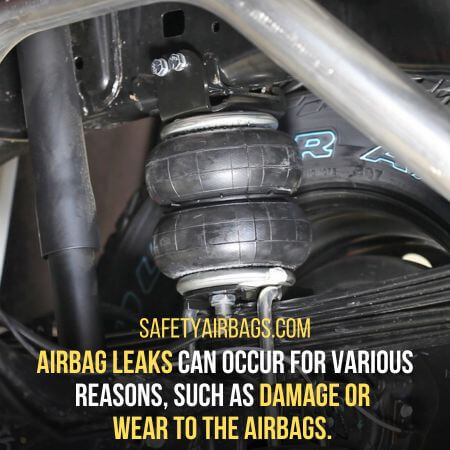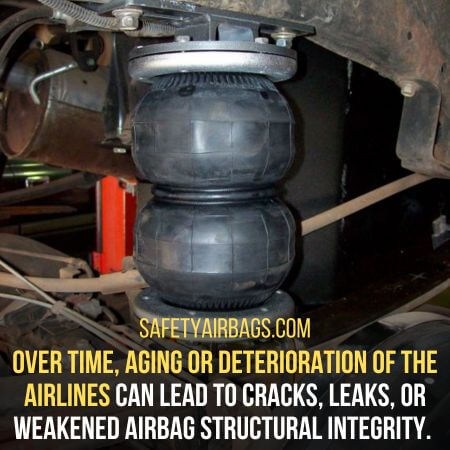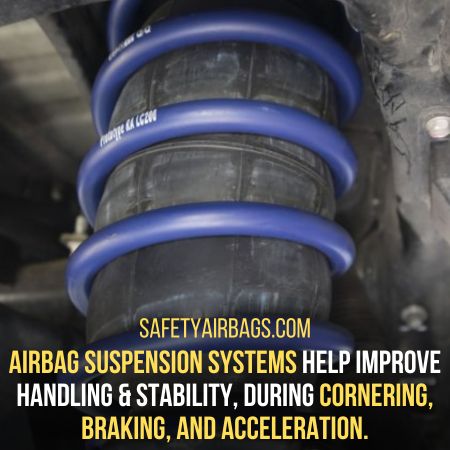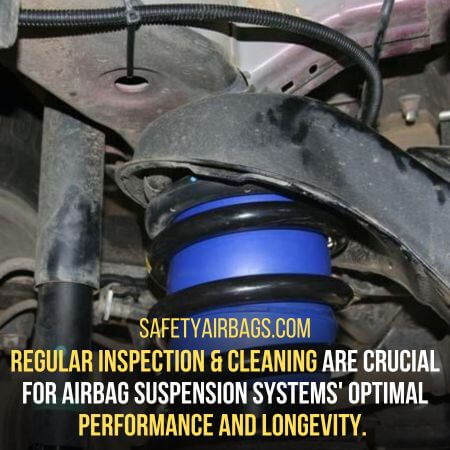Common problems with airbag suspension and airbag suspension systems include airbag leaks, compressor failure, and control system malfunctions.
What Will I learn
- 1 3 Major Common Problems with Airbag Suspension
- 2 Purpose of Airbag Suspension Systems
- 3 Components of Airbag Suspension Systems
- 4 Preventive Maintenance for Airbag Suspension Systems
- 5 Conclusion:
Regular maintenance, proper inflation, and prompt repairs are essential for addressing these issues and ensuring airbag suspension systems’ optimal performance and reliability.
3 Major Common Problems with Airbag Suspension
The primary purpose of airbag suspension systems is to provide an adjustable and comfortable ride.
They also improve the vehicle’s handling, stability, and load-carrying capacity. Some of the major problems with airbag suspension are as follows:
1. Airbag Leaks:
Airbag leaks can occur for various reasons, such as damage or wear to the airbags.

These leaks can result in a loss of air pressure and compromised suspension performance, requiring timely repair and maintenance to ensure optimal functionality.
Signs and Symptoms of Airbag Leaks:
Signs and symptoms of airbag leaks include:
– A sagging or uneven suspension
– Decreased ride height
– Air compressor running frequently
– Audible hissing or leaking sounds, and
– Visible damage or cracks on the airbags.
Prompt detection and repair are necessary to maintain the system’s performance.
Repair and Maintenance of Airbag Leaks:
Repair and maintenance of airbag leaks involve identifying the source of the leak, which may require visual inspection or pressure testing.
Depending on the severity of the leak, it may be possible to patch or repair the airbag, or it may need to be replaced entirely.
Regular inspections and proper maintenance help prevent leaks.
2. Compressor Failure:
Electrical or wiring issues, excessive dust or debris accumulation, lack of proper lubrication, and faulty pressure switches or relays can cause compressor failure in airbag suspension.
These factors can lead to the malfunctioning or complete breakdown of the compressor.
This can result in a loss of air pressure and ineffective operation of the airbag system.
Signs and Symptoms of Compressor Failure:
Signs indicating potential compressor failure in airbag suspension systems include:
– A loss of air pressure or the inability to inflate the airbags
– Unusual noises coming from the compressor, and
– The compressor is not turning on or engaging
These symptoms indicate a malfunctioning or failed compressor that requires troubleshooting and repair to restore proper functionality to the airbag system.
Troubleshooting and Repair of Compressor Failure:
Several steps can be taken to troubleshoot and repair compressor failure in airbag suspension systems. This includes:
– Checking electrical connections and fuses
– Testing the compressor motor and pressure switch for proper functionality
– Cleaning or replacing air filters
– Ensuring proper lubrication, and
– Repairing or replacing faulty components.
These troubleshooting measures aim to identify and resolve the underlying issues causing compressor failure, restoring the airbag system’s operation.
3. Faulty Air Lines and Fittings:
Various factors can cause airline and fitting issues in airbag suspension systems.
Over time, aging or deterioration of the airlines can lead to cracks, leaks, or weakened structural integrity.

Loose or damaged fittings can result from improper installation, excessive vibrations, or wear and tear.
Signs and Symptoms of Faulty Air Lines and Fittings:
Faulty airlines and fittings in an airbag suspension system can exhibit several signs and symptoms indicating potential issues.
These include air leaks or pressure loss, which may cause the vehicle to sag or have an unstable or uneven ride height.
Visual inspection may reveal damage, wear, or cracks on the airlines or fittings.
Inspection and Repair of Air Lines and Fittings:
To address faulty air lines and fittings, conduct a thorough visual inspection, tighten loose fittings, and replace damaged components.
Repair airlines using patch kits or by installing new sections. Seek professional assistance if needed for complex issues.
Purpose of Airbag Suspension Systems
Airbag or air suspension systems are designed to replace traditional coil spring suspensions in vehicles.
Airbag suspension systems offer several advantages and benefits over conventional suspension systems:
1. Adjustable Ride Height:
One of the key benefits of airbag suspension systems is the ability to adjust the vehicle’s ride height.
This feature allows drivers to raise or lower the vehicle based on specific needs, such as improving ground clearance or enhancing aerodynamics.
2. Improved Ride Comfort:
Airbags provide a smoother and more comfortable ride than traditional coil spring suspensions.
They absorb road shocks and vibrations more effectively, reducing the impact and jolting the occupant’s feel.
3. Enhanced Handling and Stability:
Airbag suspension systems improve handling and stability, especially during cornering, braking, and acceleration.

The adjustable nature of airbags allows for better weight distribution and balance, leading to enhanced vehicle control and responsiveness.
4. Load-Leveling Capability:
One of the significant advantages of airbag suspension systems is their ability to adjust the ride height and maintain a level stance automatically.
These feature benefits vehicles that frequently carry heavy loads or tow trailers, ensuring optimal performance and safety.
Components of Airbag Suspension Systems
Airbag suspension systems include airbags, an air compressor, air lines and fittings, and a control system.
These components work together to provide a comfortable and adjustable ride, enhancing vehicle stability and safety.
1. Airbags (Air Springs):
Airbags, also known as air springs, are the primary components of airbag suspension systems.
These flexible, reinforced rubber or synthetic bags are filled with compressed air to support the vehicle’s weight and provide the desired level of suspension.
Airbags are typically made of durable rubber or synthetic materials and are designed to withstand high pressures.
They are installed between the vehicle’s frame and suspension components, such as control arms or axle assemblies.
When air is pumped into the airbags, they expand and provide support, effectively replacing traditional coil springs.
Types of Airbags Used in Suspension Systems:
Several types of airbags are used in airbag suspension systems, including convoluted and sleeve-style airbags.
Convoluted airbags have a bellows-like shape with multiple folds, while sleeve-style airbags are cylindrical.
The choice of airbag type depends on the specific vehicle application and suspension requirements.
2. Air Compressor:
The air compressor is a critical component of the airbag suspension system, responsible for supplying compressed air to the airbags.
Role and Function of the Air Compressor:
The air compressor’s primary function is to generate compressed air and deliver it to the airbags to maintain the desired ride height and pressure.
It draws in ambient air, compresses it, and stores it in a reservoir or tank until needed.
Types of Air Compressors Used in Airbag Suspension Systems:
Various types of air compressors are used in airbag suspension systems, including reciprocating compressors, rotary compressors, and electric compressors.
Each type has its advantages in terms of performance, efficiency, and noise levels, and the selection depends on the specific requirements and design of the suspension system.
3. Air Lines and Fittings:
Air lines and fittings are crucial in delivering compressed air from the air compressor to the airbags.
Importance of Air Lines and Fittings:
Air lines and fittings are conduits for transporting compressed air to the airbags.
They must be durable, leak-free, and properly connected to ensure efficient and reliable air transfer.
Types of Air Lines and Fittings Used in Airbag Suspension Systems:
Common airlines used in airbag suspension systems include flexible rubber hoses or nylon tubing.
Fittings, such as connectors and couplers, join airlines and connect them to the airbags and the compressor.
These fittings need to be secure and airtight to prevent air leaks.
Preventive Maintenance for Airbag Suspension Systems
Preventive maintenance is essential for ensuring airbag suspension systems’ optimal performance and longevity:
1. Regular Inspection and Cleaning:
Regular inspection and cleaning are crucial for airbag suspension systems’ optimal performance and longevity.

It helps to identify potential issues early and maintain the system’s functionality.
2. Proper Inflation and Deflation:
Follow these guidelines for correct inflation and deflation of airbags:
– Refer to the manufacturer’s recommendations for the recommended air pressure.
– Use a reliable pressure gauge to accurately measure and adjust the air pressure.
– Avoid over-inflating or underinflating the airbags, as it can affect the system’s performance.
– Properly secure the air valve caps to prevent air leakage.
Importance of Maintaining Correct Air Pressure:
Maintaining air pressure in the airbags is vital for optimal ride quality, stability, and load-carrying capacity.
Incorrect air pressure can lead to poor suspension performance and potential damage to the system.
3. Professional Assistance and Repairs:
Professional assistance is highly recommended when it comes to complex repairs or maintenance tasks.
Qualified technicians have the knowledge, experience, and specialized tools to effectively diagnose, repair, and maintain airbag suspension systems.
Choosing a Qualified Technician or Repair Facility
Consider the following factors when selecting a qualified technician or repair facility:
– Look for technicians trained and certified in airbag suspension system repair.
– Check for recommendations or referrals from trusted sources.
– Ensure the repair facility has experience working with airbag suspension systems and the necessary equipment.
Warranty Considerations for Airbag Suspension Systems:
When seeking repairs or maintenance, be aware of the warranty coverage for your airbag suspension system.
Follow the manufacturer’s guidelines regarding warranty requirements and authorized repair facilities to avoid voiding the warranty.
Conclusion:
In conclusion, airbag suspension systems play a crucial role in providing a smooth and comfortable ride and enhancing vehicle stability and safety.
However, like any complex system, they can experience common problems that may affect their performance.
Understanding the components, potential issues, and maintenance requirements of airbag suspension systems is essential for ensuring their proper functioning.
Regular inspections, prompt repairs, and seeking professional assistance, when needed, are key to maintaining the longevity and reliability of airbag suspension systems.
